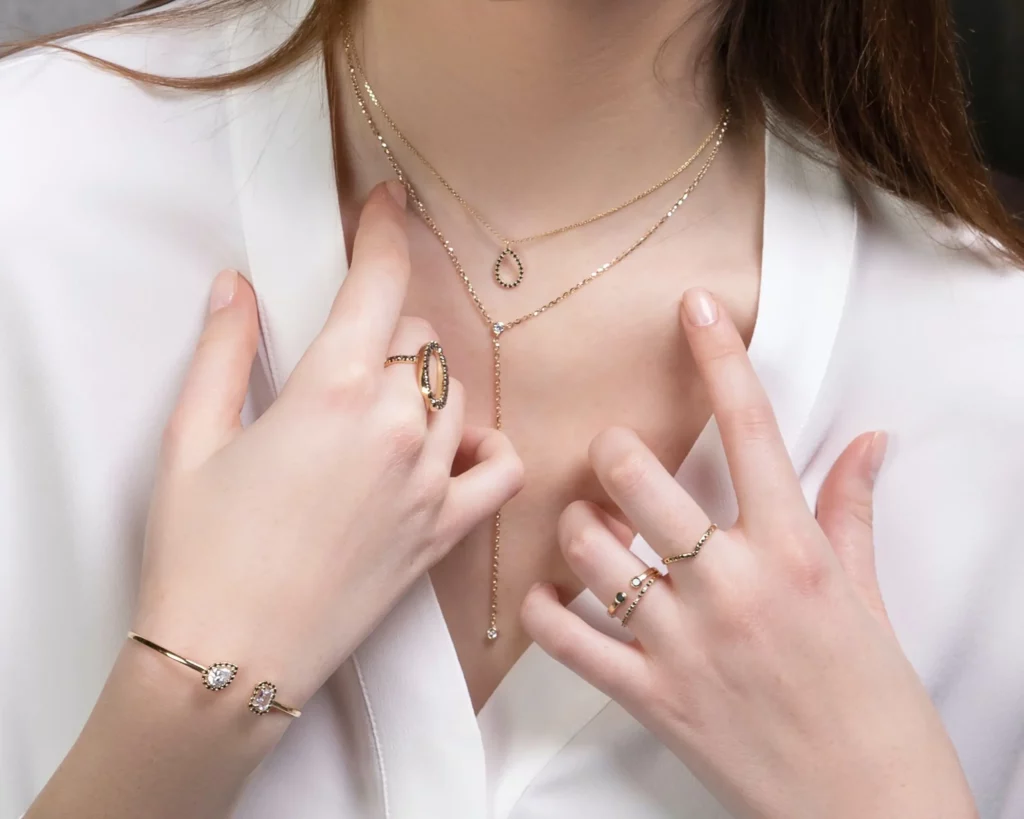When shopping for jewelry, there are lots of factors to consider that can sometimes feel overwhelming.
One of those factors you might have noticed when looking for jewelry is that many pieces are offered in different metals such as 10k gold, 14k gold, and even 18k gold.
Choosing the metal of your piece is important because it plays into the price, the longevity of the piece, the purity, and more.
Today, we’re going to share the differences between 10k vs 14k gold to help you choose the better option for your needs.
10k vs 14k Gold: Overview
First, it’s let’s start by going over some general characteristics of 10k and 14k gold.
| 10k Gold | 14k Gold |
| – Less pure than 14k gold due to being mixed with other metals – Typically cheaper than 14k gold – More durable since there is less pure gold, making it less malleable – Looks duller compared to 14k gold – More likely to trigger allergies in those with sensitivities to metals – Often found in lower-quality jewelry | – Has more purity than 10k gold due to being mixed with fewer metals – More expensive than 10k gold – Slightly more malleable due to having more pure gold – Shinier and more vibrant than 10k gold – More common in gold jewelry – Higher quality than 10k gold – More likely to scratch |
What is 10k Gold?
The majority of gold jewelry is never actually pure gold due to gold being so soft and malleable.
If jewelry were to be made out of pure gold — 24k — it wouldn’t be very durable and would get easily scratched and dented. This is why gold is mixed with other metals to make it stronger and long-lasting.
When it comes to 10k gold, 10 parts of gold are mixed with 14 parts of other metals (which adds up to 24).
With that being said, since there are fewer parts of gold in comparison to other metals, 10k gold has a lower purity.
What is 14k Gold?
Likewise, when it comes to 14k gold, that means there are 14 parts of gold mixed with 10 parts of other metals (which, again, equals 24).
In this sense, 14k gold has a higher purity since there is more pure gold in the mix.
10k vs 14k Gold: Price Differences
10k Gold
Due to it being less pure, 10k gold typically sells for cheaper when compared to 14k gold and 18k gold. Not just that, but lesser purity also means less shine and a kind of dull appearance.
In fact, 10k gold is the lowest amount of pure gold that can be legally sold in the United States. Any lower than that and the jewelry cannot be labeled as gold.
14k Gold
Meanwhile, 14k gold is pricier than 10k gold due to it being higher in purity.
In fact, 14k gold is the most popular metal when shopping for gold jewelry due to its shine and having enough pure gold to create the perfect yellow gold.
18k is also common, but since 18k is made with more gold, it is less durable and is more likely to get scratched or even break. 14k is the sweet spot, which is why so much gold jewelry uses 14k gold.
Durability Comparison
10k Gold
When it comes to durability and longevity, 10k gold has a slight upper hand due to having more metals mixed with it.
Since pure gold is very workable and soft, the less pure gold that’s in a mixture — like 10k gold — the less susceptible it is to being scratched and dented in the long run.
In a durability sense, 10k gold has an advantage.
14k Gold
Similarly, since there are more parts of pure gold in 14k gold, 14k gold is considered to be more prone to getting banged up in comparison to 10k gold.
This isn’t necessarily a bad thing – 14k gold still has a solid combination of purity and durability while still being affordable.
14k gold is still pretty durable and usually holds up even for people with active lifestyles, but wear and tear is bound to happen.
Availability
10k Gold
If you’re looking to buy a 10k gold jewelry piece, you might have to limit your jeweler choices as not many top jewelers actually sell 10k gold jewelry.
Most jewelers start at 14k rose gold, 14k white gold, and 14k yellow gold, then go up to 18k gold, then platinum.
As mentioned before, 10k gold is the minimum to even be legally considered gold jewelry in the United States, so oftentimes 10k gold is used in lower quality and cheaper jewelry.
14k Gold
14k gold is the most popular setting when it comes to engagement rings due to its well-roundedness. 14k gold is more affordable than 18k gold, has a nice finish and shine, and is fairly durable.
Because of those characteristics, 14k gold is offered at every jeweler, meaning the possibilities are endless!
In Conclusion
We hope this article helped you distinguish between 10k vs 14k gold! If you’re debating between the two, we say go with 14k gold.
14k gold is shinier, more commonly found at nearly all jewelers, and is still pretty durable (plus it’s typically budget-friendly as well).
Before you finalize your decision, you’ll also want to compare gold plating, vermeil or gold-filled, and solid gold since these are all different as well. Read our recommended article below to learn the difference between gold-filled and gold-plated jewelry!
NEXT UP: Here’s the Difference Between Gold-Filled and Gold-Plated Jewelry

